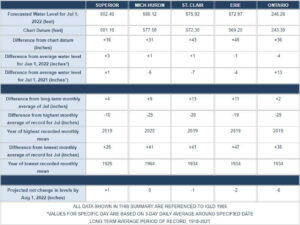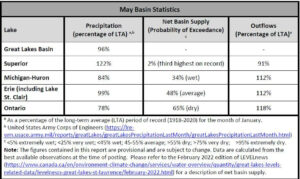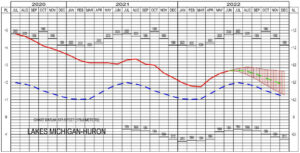2022-Jul-04
July 3 Water Levels Report
Recently the Great Lakes basin has been drier than normal and this is expected to continue in the coming weeks. Lake Michigan-Huron continues to be below the level it was at this time last year – see first graph below.
From a month ago the water levels on Lakes Superior, Michigan-Huron & St Clair are up 3, 1, & 1 inches respectively, and Lakes Erie & Ontario are down 1 & 4 inches respectively. Lakes Michigan-Huron, St Clair & Erie are lower by 6, 7 & 4 inches respectively, and Lakes Superior and Ontario are up 1 & 13 inches respectively, than they were at this time last year. Lakes Superior, Michigan-Huron, St Clair, Erie & Ontario are 4, 9, 13, 11 & 2 inches, respectively, above their long term July average. All the lakes remain well below their July record highs.
In a month’s time Lakes Superior & Michigan-Huron are forecast to be up 1 & 0 inches respectively, and Lakes St Clair, Erie & Ontario are forecast to be down 1, 2 & 6 inches respectively.

![]()

Outflows from Lake Superior into the St. Mary’s River, Lake Michigan-Huron’s outflow into the St. Clair River, Lake St. Clair’s outflow through the Detroit River, Lake Erie’s outflow through the Niagara River and Lake Ontario’s outflow through the St. Lawrence River are all projected to be above average for this month.
This report below shows the most recent month of precipitation and outflows published by Level News:

With regard to the forecast graph below, and the more recently updated first graph in this report, the USACE is predicting that the most likely outcome is that the Lake Michigan-Huron level will continue its seasonal rise through June, level off in July, and commence its seasonal decline in August, through November and into December.
Monthly mean water levels for the previous year and the current year to date are shown as a solid line on the hydrographs. A projection for the next six months is given as a dashed line. This projection is based on the present condition of the lake basin and anticipated future weather. The shaded area shows a range of possible levels over the next six months dependent upon weather variations. Current and projected levels (solid and dashed lines) can be compared with the 1918-2019 average levels (dotted line) and extreme levels (shown as bars with their year of occurrence). The legend below further identifies the information on the hydrographs.


